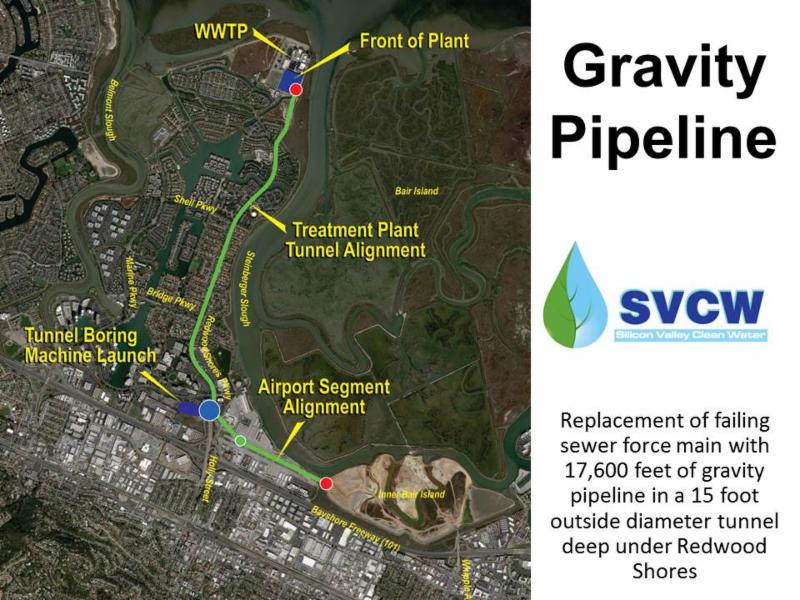The Silicon Valley Clean Water (SVCW) Commission on Thursday, April 13, approved the Regional Environmental Sewer Conveyance Upgrade (RESCU) Program, which consists of replacing or rehabilitating nearly all components of the existing conveyance system, including pipelines and pump stations.
As a prerequisite to project approval, the Commission also:
- Certified the final project environmental impact report, an informational document that assesses the potential environmental impacts and identifies mitigation measures that could reduce or avoid adverse environmental impacts.
- Adopted findings of fact and a mitigation monitoring and reporting program. Results of the environmental impact assessment indicate that the RESCU would not result in any significant and unavoidable impacts, as all significant impacts are capable of being reduced to less than significant levels through implementation of mitigation measures which became part of project approval.
The project objectives are:
- Replace the existing wastewater infrastructure and other improvements to the conveyance system to ensure reliable operation of the overall wastewater conveyance system in accordance with San Francisco Bay Regional Water Quality Control Board (RWQCB) permit conditions.
- Reduce the likelihood of spills and discharges of untreated sewage to the surrounding environment, which has occurred numerous times with the existing 45-year-old concrete sewer force main that operates above its design pressure.
- Implement a project that minimizes adverse environmental effects, adverse impacts to public health and private property owners, utility interference and disruption during construction, and short-term and long-term costs.
- Improve plant process reliability, and increase operational readiness.
- Meet future regulatory requirements imposed by the RWQCB for nutrients discharged into the San Francisco Bay.
Two key components of RESCU ready for implementation are the gravity pipeline and the front-of-plant projects. The $220 million gravity pipeline project is the replacement of the 48-inch and 54-inch force main segments between Bair Island and the SVCW treatment plant at 1400 Radio Road, Redwood City. The $93 million front-of-plant project includes a Receiving Lift Station, a Headworks, an Influent Connector Pipeline, and other support facilities, all located at the previous site of the recycled water landscape impoundment.
Both the gravity pipeline project and the front-of-plant project will use a progressive design- build (PDB) process, with selection of PDB firms spanning the next five months and staff making a recommendation for awarding the design-build contracts to the Commission in October. It is at that time the monetary expenditures assigned to each project component will be authorized by the SVCW Commission.
It is anticipated that the schedule for the gravity pipeline design and construction will take from fall 2017 through summer 2022. The current schedule for the front-of-plant facilities design and construction span from fall 2017 to fall 2022. Both projects are anticipated to start construction in mid-2018 to late 2018, but site preparation construction activity will occur at the front-of-plant area in summer 2017 to avoid wet weather impacts to this portion of the project.
The Commission on April 13 also authorized task orders and budgets for consulting support for these projects, including:
- Water Environmental Technical Consulting (WET). Its principal, Chuck Fenton, has more than 30 years of experience in water and wastewater treatment and extensive specific experience in operations, maintenance, training, troubleshooting, plant optimization, laboratory analysis, and new plant startups.
- Technical Edge has extensive experience in the wastewater field encompassing electrical, instrumentation, controls, SCADA, programmable logic controllers (PLC’s) and the design and integration of all components to implement a fully automated system.
- The law firm of Hanson Bridgett for services related to public works contracting and construction legal services. Hanson Bridgett has specialized in public agency law for more than 50 years and possesses particular expertise in alternative project delivery.
- Freyer & Laureta, Inc. of San Mateo for continued geotechnical and civil engineering services for the front-of-plant projects. To construct these improvements, the soil must be stabilized. The soil in this area is called Young Bay Mud, which has very low supportive strength. Construction equipment would not be able to operate on this soil without sinking into the soil. The additional scope with Freyer & Laureta is for preparing the site for future construction activities, including pavement design of a new roadway and parking area for staff access and utilities design associated with these areas. Upon completion of the roadway and parking area, along with the soil stabilization, the area to receive the front-of-plant facilities will be ready for the design-builder to mobilize. Construction of this project is anticipated to begin in July 2017.
RESCU is made of up 17 components, each consisting of specific improvements and upgrades to portions of the conveyance system and the wastewater treatment plant. Each component has a separate schedule and timing for implementation. The project components are located within the cities of Belmont, Menlo Park, Redwood City, and San Carlos .
They will ensure that SVCW can efficiently, reliably, and safely convey and treat wastewater from its four member agencies, Belmont, San Carlos, Redwood City, and the West Bay Sanitary District ( which provides sanitary sewer collection services to the cities of Menlo Park, Portola Valley, and portions of Atherton, Woodside, East Palo Alto, and unincorporated areas of San Mateo County) for many decades to come.
The individual members of the JPA own and operate the sanitary sewer collection systems within their respective jurisdictions, and SVCW owns and operates the wastewater treatment plant (WWTP) as well as the sanitary sewer force main and pump stations that convey the sewage to the treatment plant.
